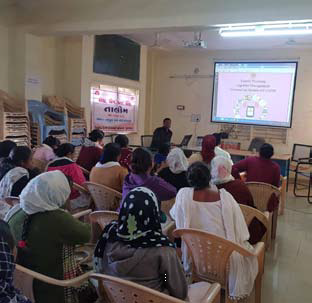Improving Family Planning Commodity Logistic Management (Gujarat)
Improving Family Planning Commodity Logistic Management (Gujarat)
Problem Statement
An efficient and uninterrupted supply chain for Family Planning (FP) commodities forms the back bone of FP Programme and is imperative for its successful implementation. The digitalization of supply chain has revolutionised the health system. The earlier paper based manual system had many shortcomings such as poor inventory management, top down push for commodities, no source for real time information on demand of supplies, difficulty in compiling and analysing data at state or district level. These issues led to overstocking/shortage and stock outs of commodities at different facilities.
Programme Description
In order to streamline FP commodities management across the country GoI launched FPLMIS. It is a web based, mobile app and SMS based application for assisting in collection, processing, indenting and monitoring utilization of family planning logistics. This system is envisaged to be used by health functionaries at all level starting from ASHA to the state level Programme managers. Gujarat state rolled out FPLMIS in 2017-18.
Gujarat as a front runner in implementation of Programme has adopted various approaches including the following:
- A cascade model of training. Master trainers trained at national level provided training at State level. Total six regional training batches were organized and Additional District Health officers (Nodal FP officer), District Programme Co-ordinators (NHM) and pharmacists were the primary target audience for these training. Further trainings were organized by regional and district administration. So far, more than 33,000 Healthcare functionariesin cluding ASHAs have been trained on use of FPLMIS.
- Training presentations were translated in to vernacular language to increase understandings of ASHAs on FPLMIS. SMS codes for indenting have also been translated and pasted on to ASHA diaries across the state as ready reckoner.
- To provide constant monitoring & supportive supervision, SATCOMs and video conferences are organized at regular interval to provide guidance and resolve queries.
Programme Outcomes
State level monitoring and supportive supervision is being continued to see utilization of FPLMIS. As of October 2019, more than 90% facilities (2000/2216) are using FPLMIS for indenting in Gujarat. 64% of sub centres (5974/9231) and 46% of ASHAs (17641/38213) are also using it regularly for indenting. Indenting from district ware houses has also increased from merely 7% in 2017-18 to 100% in 2019-20.
Challenges & Lessons Learned
Acceptance of new digitalized system over the age old paper based system was a challenge. However, peer support from the younger and computer literate FHWs/ ASHAs have now motivated all health care workers to use the system. Mass indenting by all FHWs & ASHAs during ASHA sammelen were tried out to percolate peer learning and was found to be very useful.
Way Forward
FPLMIS has helped tremendously in streamlining logistic management of FP commodities. Now the focus is on ensuring compliance to this supply related aspect as well as on demand generation activities at community level.

Source : We Care Coffee Table Book - Good, Replicable and Innovative Practices 2019
Last Modified : 6/11/2021
This topic provides information about Organic Valu...
This topic provides information about Converting F...
This topic provides information about Block Task F...
This topic provides information about Ashraya - Pa...
